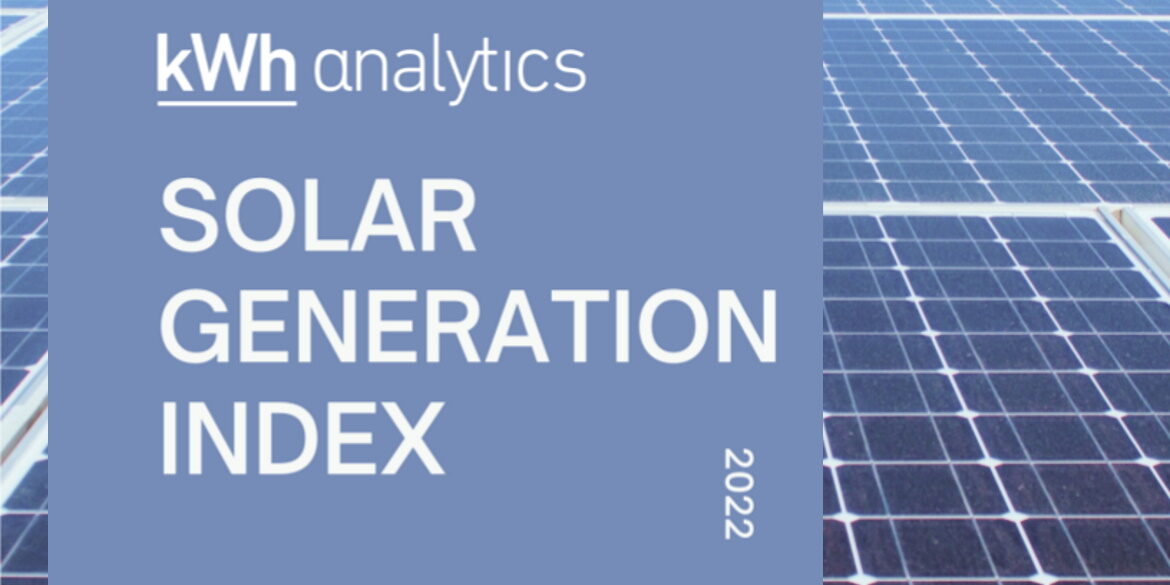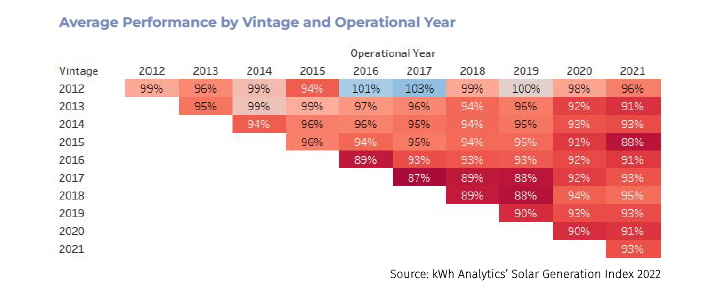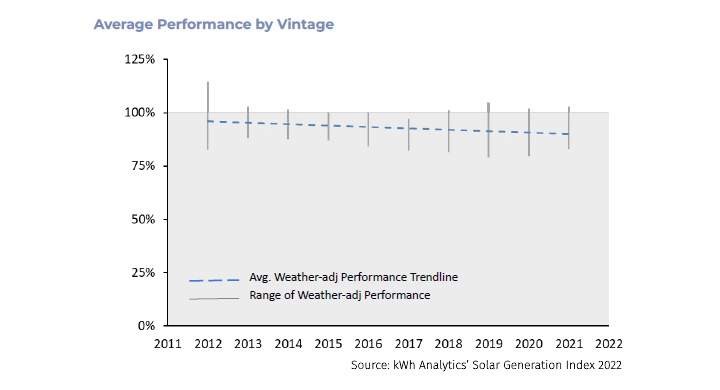Despite continued supply chain disruptions in 2022, the U.S. solar industry’s outlook appears strong with the passage of the Inflation Reduction Act (IRA). SEIA and Wood Mackenzie have increased their U.S. solar deployment forecast, expecting the industry to triple in size over the next five years. With the increased level of long-term certainty brought by the IRA, it’s more important than ever that solar assets perform reliably and within their original P50 production estimates.
To promote transparency in the solar industry and help asset owners and financiers determine whether solar assets are meeting project financing expectations, kWh Analytics published the Solar Generation Index 2022 report (SGI) in December 2022. The SGI is a comprehensive analysis of utility-scale, weather-adjusted performance relative to expectations. For the third year in a row, kWh Analytics selected SolarAnywhere’s high-fidelity, bankable and industry-vetted solar data for all 500+ assets included in the analysis.
Solar Generation Index 2022 findings: the underperformance trend continues
The results of the third edition have not changed the narrative from the previous two SGI reports. Solar assets across the U.S. continued to underperform in 2021, independent of asset size, region and mount type. On average, solar asset P50 underperformance ranges between 7-13% for projects constructed after 2015. This nationwide trend is independent of single-axis tracker or fixed-tilt systems, which both produced about 8% less power than was expected—per their pro formas—at project financing.
Older projects—those constructed in the early 2010’s—performed better than new builds, putting project assumptions for newer assets into question. Such levels of asset underperformance jeopardize solar investor returns, risking the asset’s long-term financial health and guaranteed access to necessary capital investments.
It’s imperative that solar assets show predictable and healthy levels of performance for four main reasons:
- Developers that can consistently deliver high-quality PV assets with no weather-adjusted P50 performance discrepancies can benefit from a strong reputation, which in return can lead to healthy margin growth
- Asset managers can more efficiently operate and maintain PV assets when production outputs are in line with expected results independent of weather seasonality
- Solar asset owners that see consistent, stable returns can de-risk their overall portfolio and allow for predictable cash flow management
- Grid operators can only effectively manage an increasingly intermittent load with predictable PV output forecasts
Factors contributing to the underperformance trend
Accurate yield predictions are required more than ever for the financial health and stability of the solar industry. Of all the factors that can affect solar energy prediction accuracy, solar resource data contributes a significant amount: up to 3-5% of the uncertainty (1-sigma) in P50 energy production estimates.
While non-bankable solar resource data options might be a practical prospecting solution, Clean Power Research recommends relying on a highly accurate, consistent and industry-accepted weather data solution for project development and financing. This allows for data consistency and comparability across the entire PV project lifecycle. SolarAnywhere global horizontal irradiance (GHI) data is shown to be accurate within +/-4.5% on an annual basis with 95% confidence, and is trusted by the solar industry for independent and bankable solar resource assessment, operational monitoring and solar forecasting.
In addition to weather data uncertainty, other assumptions at the energy modeling stage also materially impact yield predictions. For example, soiling loss inputs in energy models can contribute up to 4% of uncertainty in P50 estimates. To make soiling and snow loss estimates more transparent, site-specific and data-driven, SolarAnywhere leverages it’s full historical, high-fidelity time-series data with industry-vetted soiling and snow loss models in pvlib.
Reduce uncertainty and increase confidence in energy estimates with high-fidelity data and greater model transparency
As the solar industry continues to mature and grow, kWh Analytics calls for more industry collaboration to provide greater transparency, more operational data insights and consistent approaches in P50 modeling practices. As an active participant and contributor to the open-source pvlib community, Clean Power Research continues to foster innovation and research in PV modeling, promoting greater transparency and collaboration across the solar PV community. Solar stakeholders can act today to improve P50 estimates by working with bankable, validated and highly accurate weather-data sources that specialize in solar, and demonstrate consistent and globally repeatable solar data outputs.
SolarAnywhere is trusted by developers, asset owners and operators around the world as the low-bias, high-quality solar data resource for all stages of the solar project lifecycle. To learn more about how SolarAnywhere supports reliable and objective yield predictions, contact us today.


